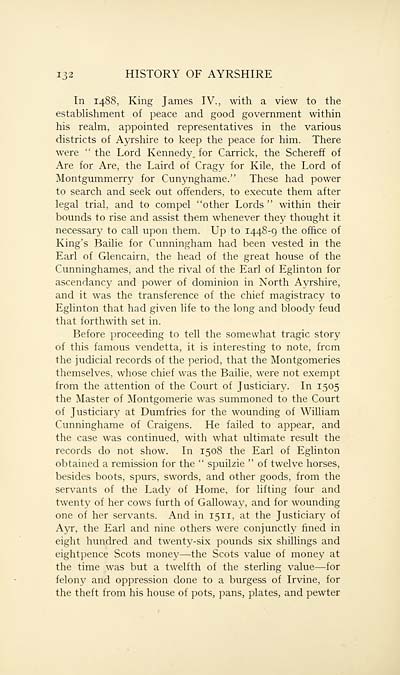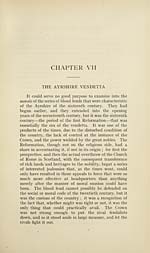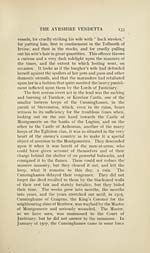Download files
Complete book:
Individual page:
Thumbnail gallery: Grid view | List view

132 HISTORY OF AYRSHIRE
In 1488, King James IV., with a view to the
establishment of peace and good government within
his realm, appointed representatives in the various
districts of Ayrshire to keep the peace for him. There
were ' ' the Lord Kennedy, for Carrick, the Schereff of
Are for Are, the Laird of Cragy for Kile, the Lord of
Montgummerry for Cunynghame." These had power
to search and seek out offenders, to execute them after
legal trial, and to compel "other Lords " within their
bounds to rise and assist them whenever they thought it
necessary to call upon them. Up to 1448-9 the office of
King's Bailie for Cunningham had been vested in the
Earl of Glencairn, the head of the great house of the
Cunninghames, and the rival of the Earl of Eglinton for
ascendancy and power of dominion in North Ayrshire,
and it was the transference of the chief magistracy to
Eglinton that had given life to the long and bloody feud
that forthwith set in.
Before proceeding to tell the somewhat tragic story
of this famous vendetta, it is interesting to note, from
the judicial records of the period, that the Montgomeries
themselves, whose chief was the Bailie, were not exempt
from the attention of the Court of Justiciary. In 1505
the Master of Montgomerie was summoned to the Court
of Justiciary at Dumfries for the wounding of William
Cunninghame of Craigens. He failed to appear, and
the case was continued, with what ultimate result the
records do not show. In 1508 the Earl of Eglinton
obtained a remission for the " spuilzie " of twelve horses,
besides boots, spurs, swords, and other goods, from the
servants of the Lady of Home, for lifting four and
twenty of her cows furth of Galloway, and for wounding
one of her servants. And in 1511, at the Justiciary of
Ayr, the Earl and nine others were conjunctly fined in
eight hundred and twenty-six pounds six shillings and
eightpence Scots money — the Scots value of money at
the time was but a twelfth of the sterling value — for
felony and oppression done to a burgess of Irvine, for
the theft from his house of pots, pans, plates, and pewter
In 1488, King James IV., with a view to the
establishment of peace and good government within
his realm, appointed representatives in the various
districts of Ayrshire to keep the peace for him. There
were ' ' the Lord Kennedy, for Carrick, the Schereff of
Are for Are, the Laird of Cragy for Kile, the Lord of
Montgummerry for Cunynghame." These had power
to search and seek out offenders, to execute them after
legal trial, and to compel "other Lords " within their
bounds to rise and assist them whenever they thought it
necessary to call upon them. Up to 1448-9 the office of
King's Bailie for Cunningham had been vested in the
Earl of Glencairn, the head of the great house of the
Cunninghames, and the rival of the Earl of Eglinton for
ascendancy and power of dominion in North Ayrshire,
and it was the transference of the chief magistracy to
Eglinton that had given life to the long and bloody feud
that forthwith set in.
Before proceeding to tell the somewhat tragic story
of this famous vendetta, it is interesting to note, from
the judicial records of the period, that the Montgomeries
themselves, whose chief was the Bailie, were not exempt
from the attention of the Court of Justiciary. In 1505
the Master of Montgomerie was summoned to the Court
of Justiciary at Dumfries for the wounding of William
Cunninghame of Craigens. He failed to appear, and
the case was continued, with what ultimate result the
records do not show. In 1508 the Earl of Eglinton
obtained a remission for the " spuilzie " of twelve horses,
besides boots, spurs, swords, and other goods, from the
servants of the Lady of Home, for lifting four and
twenty of her cows furth of Galloway, and for wounding
one of her servants. And in 1511, at the Justiciary of
Ayr, the Earl and nine others were conjunctly fined in
eight hundred and twenty-six pounds six shillings and
eightpence Scots money — the Scots value of money at
the time was but a twelfth of the sterling value — for
felony and oppression done to a burgess of Irvine, for
the theft from his house of pots, pans, plates, and pewter
Set display mode to:
![]() Universal Viewer |
Universal Viewer | ![]() Mirador |
Large image | Transcription
Mirador |
Large image | Transcription
Images and transcriptions on this page, including medium image downloads, may be used under the Creative Commons Attribution 4.0 International Licence unless otherwise stated. ![]()
| Histories of Scottish families > Ayrshire > Volume 1 > (142) Page 132 |
|---|
| Permanent URL | https://digital.nls.uk/95195990 |
|---|
| Attribution and copyright: |
|
|---|
| Description | A selection of almost 400 printed items relating to the history of Scottish families, mostly dating from the 19th and early 20th centuries. Includes memoirs, genealogies and clan histories, with a few produced by emigrant families. The earliest family history goes back to AD 916. |
|---|

